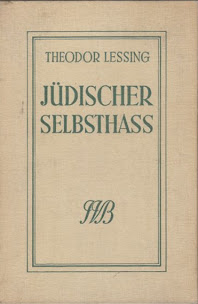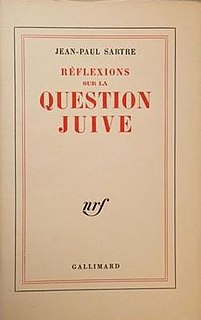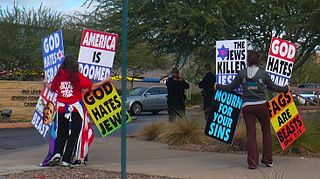Related Research Articles
Antisemitism is hostility to, prejudice towards, or discrimination against Jews. A person who holds such positions is called an antisemite. Antisemitism is considered to be a form of racism.
The history of antisemitism, defined as hostile actions or discrimination against Jews as a religious or ethnic group, goes back many centuries, with antisemitism being called "the longest hatred". Jerome Chanes identifies six stages in the historical development of antisemitism:
- Pre-Christian anti-Judaism in Ancient Greece and Rome which was primarily ethnic in nature
- Christian antisemitism in antiquity and the Middle Ages which was religious in nature and has extended into modern times
- Muslim antisemitism which was—at least in its classical form—nuanced, in that Jews were a protected class
- Political, social and economic antisemitism during the Enlightenment and post-Enlightenment Europe which laid the groundwork for racial antisemitism
- Racial antisemitism that arose in the 19th century and culminated in Nazism
- Contemporary antisemitism which has been labeled by some as the new antisemitism

Dan Mark Cohn-Sherbok is a rabbi of Reform Judaism and a Jewish theologian. He is Professor Emeritus of Judaism at the University of Wales.
Rootless cosmopolitan was a pejorative Soviet epithet which referred mostly to Jewish intellectuals as an accusation of their lack of full allegiance to the Soviet Union, especially during the antisemitic campaign of 1948–1953. This campaign had its roots in Joseph Stalin's 1946 attack on writers who were connected with "bourgeois Western influences", culminating in the "exposure" of the non-existent Doctors' Plot in 1953.
New antisemitism is the idea that a new form of antisemitism has developed in the late 20th and early 21st centuries, tending to manifest itself as opposition to Zionism and criticism of the Israeli government. The concept is included in some definitions of antisemitism, such as the Working Definition of Antisemitism and the 3D test of antisemitism.

The Culture of Critique series is a trilogy of books by Kevin B. MacDonald, an antisemitic conspiracy theorist, white supremacist and a retired professor of evolutionary psychology. MacDonald claims that evolutionary psychology provides the motivations behind Jewish group behavior and culture. Through the series, MacDonald asserts that Jews as a group have biologically evolved to be highly ethnocentric and hostile to the interests of white people. He asserts Jewish behavior and culture are central causes of antisemitism, and promotes conspiracy theories about alleged Jewish control and influence in government policy and political movements.

Self-hating Jew or self-loathing Jew, both associated with auto-antisemitism, is a term which is used to describe Jews whose views are perceived as antisemitic. The concept gained widespread currency after Theodor Lessing's 1930 book Der jüdische Selbsthaß, which sought to explain a perceived inclination among Jewish intellectuals, toward inciting antisemitism, by stating their views about Judaism. The term is said to have become "something of a key term of opprobrium in and beyond Cold War-era debates about Zionism".

Anti-Semite and Jew is an essay about antisemitism written by Jean-Paul Sartre shortly after the Liberation of Paris from German occupation in 1944. The first part of the essay, "The Portrait of the Antisemite", was published in December 1945 in Les Temps modernes. The full text was then published in 1946.

Racial antisemitism is prejudice against Jews based on a belief or assertion that Jews constitute a distinct race that has inherent traits or characteristics that appear in some way abhorrent or inherently inferior or otherwise different from the traits or characteristics of the rest of a society. The abhorrence may find expression in the form of discrimination, stereotypes or caricatures. Racial antisemitism may present Jews, as a group, as a threat in some way to the values or safety of a society. Racial antisemitism can seem deeper-rooted than religious antisemitism, because for religious antisemites conversion of Jews remains an option and once converted the "Jew" is gone. In the context of racial antisemitism Jews cannot get rid of their Jewishness.

Robert Solomon Wistrich was the Erich Neuberger Professor of European and Jewish history at the Hebrew University of Jerusalem, and the head of the University's Vidal Sassoon International Center for the Study of Antisemitism. Wistrich considered antisemitism "the longest hatred" and viewed Anti-Zionism as its latest incarnation. According to Scott Ury, "More than any other scholar, Wistrich has helped integrate traditional Zionist interpretations of Jewish history, society, and fate into the study of antisemitism." Other researchers have reproduced much of his work without questioning its founding assumptions.
Anti-Judaism is the "total or partial opposition to Judaism as a religion—and the total or partial opposition to Jews as adherents of it—by persons who accept a competing system of beliefs and practices and consider certain genuine Judaic beliefs and practices inferior."
Antisemitic canards are "sensational reports, misrepresentations, or fabrications" that are defamatory towards Judaism as a religion or defamatory towards Jews as an ethnic or religious group. Since the Middle Ages, they have formed parts of broader antisemitic conspiracy theories.
Antisemitism —prejudice, hatred of, or discrimination against Jews has experienced a long history of expression since the days of ancient civilizations, with most of it having originated in the Christian and pre-Christian civilizations of Europe.

Antisemitism in the United States has existed for centuries. In the United States, most Jewish community relations agencies draw distinctions between antisemitism, which is measured in terms of attitudes and behaviors, and the security and status of American Jews, which are both measured by the occurrence of specific incidents. FBI data shows that in every year since 1991, Jews were the most frequent victims of religiously motivated hate crimes, according to a report which was published by the Anti-Defamation League in 2019. Evidence suggests that the true number of hate crimes against Jews is underreported, as is the case for many other targeted groups.
Anti-Zionism is opposition to Zionism. The term is broadly defined in the modern era as opposition to the State of Israel or, prior to 1948, the Jewish community in the Land of Israel, as well as to the political movement of Jews to self-determination.
The 1917 Russian Revolution overthrew a centuries-old regime of official antisemitism in the Russian Empire, dismantling its Pale of Settlement. However, the previous legacy of antisemitism was continued by the Soviet state, especially under Joseph Stalin. After 1948, antisemitism reached new heights in the Soviet Union, especially during the anti-cosmopolitan campaign, in which numerous Yiddish-writing poets, writers, painters and sculptors were killed or arrested. This culminated in the so-called Doctors' plot, in which a group of doctors were subjected to a show trial for supposedly having plotted to assassinate Stalin.

Criticism of the Israeli government, often referred to simply as criticism of Israel, is a subject of journalistic and scholarly commentary and research within the scope of international relations theory, expressed in terms of political science. Within the scope of global aspirations for a community of nations, Israel has faced international criticism since its declaration of independence in 1948 relating to a variety of topics, both historical and contemporary.
Economic antisemitism is antisemitism that uses stereotypes and canards that are based on negative perceptions or assertions of the economic status, occupations or economic behaviour of Jews, at times leading to various governmental policies and laws that target or which disproportionately impact the economic status, occupations or behaviour of Jews.
The "three Ds" or the "3D test" of antisemitism is a set of criteria which was formulated by Israeli politician Natan Sharansky in order to distinguish legitimate criticism of Israel from antisemitism. The three Ds stand for delegitimization, demonization, and double standards, each of which, according to the test, indicates antisemitism. The test is intended to draw the line between legitimate criticism of the State of Israel, its actions and policies, and non-legitimate criticism which becomes antisemitic. The three Ds test is intended to rebut arguments which say that "any criticism toward the State of Israel is considered antisemitic, and therefore legitimate criticism is silenced and ignored". This test was adopted by the U.S. Department of State in 2010, and replaced by the Working Definition of Antisemitism in 2017. The test, however, has been criticized for vagueness and its use to define criticism of Israel as antisemitic.
The Khazar hypothesis of Ashkenazi ancestry, often called the Khazar myth by its critics, is a largely abandoned historical hypothesis. The hypothesis postulated that Ashkenazi Jews were primarily, or to a large extent, descended from Khazars, a multi-ethnic conglomerate of mostly Turkic peoples who formed a semi-nomadic khanate in and around the northern and central Caucasus and the Pontic–Caspian steppe. The hypothesis also postulated that after collapse of the Khazar empire, the Khazars fled to Eastern Europe and made up a large part of the Jews there. The hypothesis draws on some medieval sources such as the Khazar Correspondence, according to which at some point in the 8th–9th centuries, a small number of Khazars were said by Judah Halevi and Abraham ibn Daud to have converted to Rabbinic Judaism. The scope of the conversion within the Khazar Khanate remains uncertain, but the evidence used to tie the Ashkenazi communities to the Khazars is meager and subject to conflicting interpretations.